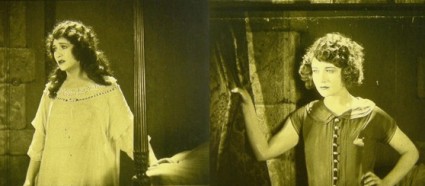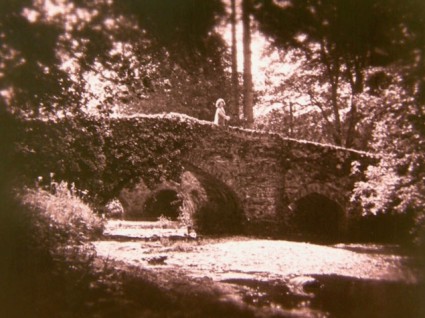Betty Compson as the good and evil twins in The White Shadow (1923), from the National Film Preservation Foundation
Terrific news has spread all across the wires today. A lost film by one of the leading British directors of the silent era, Graham Cutts, has been discovered in New Zealand. The film is The White Shadow, made in 1923. It starred the American actress Betty Compson, who had been brought over to star in three British films at the exalted sum of £1,000 a week, and Clive Brook, British-born but on his way to success in Hollywood riding on the back of the trio of films he made with Compson. Sadly, the film does not survive in a complete state. Around 30 minutes has been found. But it’s an important discovery for all that – as a product of a the work of a talented production team, as a notable starring vehicle, and as an example of the directorial work of Graham Cutts.
Graham Cutts (1885-1958) was arguably the leading British film director of the 1920s. Working with Herbert Wilcox and then Michael Balcon, two of Britain’s top producers of the period, Cutts made stylish romantic dramas characterised by fluid narrative, sumptuous production (on slim budgets) and subtly emotional performances. It could be argued that he was the first British film director to think cinematically. In particular he proved his worth by bringing out the best in some of the many American stars who were brought over to appear in British films at this time, such as Mae Marsh in Paddy-the-Next-Best-Thing (1923), Alice Joyce in The Passionate Adventure (1924), Jane Novak in The Prude’s Fall (1925) and Betty Compson in Woman to Woman (1923). This was a huge hit at the time, and is arguably the most sought-after lost British silent film – at least on artistic grounds or importance to film history.
The White Shadow, from the National Film Preservation Foundation
Woman to Woman starred Compson and Brook, and was hit with both audiences and critics, who admired its maturity of style and theme. Produced for Balcon-Saville-Freedman (Michael Balcon, Victor Saville and John Freedman), the film was directed by Cutts and produced by Michael Balcon, the first film to be made by one of British cinema’s most notable production talents. The success of the film led to a second made by the much the same production team. This was The White Shadow (1923), a tale of twins, one good, one bad, each played by Betty Compson. The verdict at the time was that the film was not as successful, commercially or artistically, as Woman to Woman, but we will have to wait until what survives of the film is made generally available to judge what we think of the latter.
Graham Cutts would go on to make a number of notable films for Balcon’s Gainsborough Studios, this time showing how to bring the best out of British stars. The Rat (1925), starring Ivor Novello as a Parisian apache, was very popular and is one of those British silents that still works well with general audiences today. It inspired two sequels. Cutts also made the accomplished The Sea Urchin (1926) with Betty Balfour and The Rolling Road with Flora Le Breton (1928). His star waned in the latter half of the decade, probably exacerbated by an awkward personality (he was obsessively jealous of his fellow filmmakers), but he continued to do some professional, if low-key work in the 1930s (the boisterous Just William, made in 1939, is a Bioscope favourite).
And yes, of course, there is some extra interest in The White Shadow because of its assistant director, art director, dialogue writer and editor. The same man undertook all four functions, and he was Alfred Hitchcock. The news has gone round the world that this is a rediscovered Alfred Hitchcock film, which is a little misleading. It is something that will have undoubtedly had Cutts whirling in his grave, because he was particularly resentful of how the young man’s talent came to eclipse his own, so that by the end of the decade the pre-eminent talent in British film was not Graham Cutts but his presumptuous protégé. Hitchcock had entered film production in 1920 as a title writer, and had directed two short films (the unfinished and lost Number Thirteen and Always Tell Your Wife, of which half survives), before joining Balcon’s team as an all-purpose talent. He was assistant director, art director and co-scriptwriter on Woman to Woman, and told Truffaut the following about working with Cutts:
FT: Graham Cutts directed that Picture [Woman to Woman]. You did the adaptation and dialogue, and were assistant director as well?
AH: More than that! My friend, the art director, was unable to work on the picture. I volunteered to serve as art director. So I did all of this and also helped on the production. My future wife, Alma Reville, was the editor of the picture as well as the script girl. In those days the script girl and the editor were the same person … It was while working on that picture that I first met my wife.
Then I performed these various functions for several other films. The second was The White Shadow …
The White Shadow – three reels of it – was discovered in the New Zealand Film Archive by archivist Leslie Lewis, having originally been in the collection of New Zealander projectionist and collector Jack Murtagh. It is to recieve its “re-premiere” on 22 September 2011 at the Academy of Motion Picture Arts and Sciences’ Samuel Goldwyn Theater. There are reports on the National Film Preservation Foundation and in the LA Times, neither unfortunately doing Cutts’ reputation many favours. Let’s turn such shallow historio-filmography around. Alfred Hitchcock’s doesn’t need any new find to bolster up his reputation; Graham Cutts is the one in need of rediscovery. His was a real and important talent. Now we have a little more in the way surviving archive by which to celebrate it.


It will be playing at Pordenone!
Scoop! You heard it here first folks. I shall be there – it would make a quite a double-bill with The Soldier’s Courtship …
Pingback: The Hitchcock Vanishes | sempre in penombra
I’m happy you turned this around in the proper direction, as a rediscovered Cutts film. Many newspaper accounts seem to imply that Cutts was a hack or a minor talent.
A little bit tongue-in-cheek, but much of the press coverage has been predictably sloppy. Cutts was a reasonable director for his time who wasn’t able to raise his game when the rest of the industry around him raised theirs, and he became bitter. He merits a retrospective from someone (British Silent Film Festival to the rescue, maybe?).
The BFI should be doing it!
Just as I have noted this article there, a lively and sarcastic discussion on the subject is going on here:
http://nitrateville.com/viewtopic.php?f=1&t=9950
Bob
It gets worse. The regular BBC News site’s Quiz of the Week’s has a question on The White Shadow: http://www.bbc.co.uk/news/magazine-14407807
“The first three reels of Alfred Hitchcock’s film The White Shadow, dating from 1923, have been discovered. It is thought to be his earliest surviving work but how old was he when he worked on it? 18, 24 or 31?”
Well it’s not an Alfred Hitchcock film (if we’re going to be exactly auteurist about this) and it’s not his earliest surviving film anyway – Always Tell Your Wife (half of which survives) dates from 1923. Just can’t trust the BBC with anything, can you?
(The answer’s 24, by the way)
Well done Luke – was terribly confused by the news of a lost Hitchcock but I suppose sadly a lost Cutts film does not have the same media pull. By the way did you see the Acres films on my Fairground documentary we showed boxing kangaroo and skipping animals titles
I think the hearts of many of us skipped a beat when we saw the headlines, thinking that The Mountain Eagle had been found.
I didn’t know about and therefore missed the fairground programme (Timeshift: All the Fun of the Fair), but I’ll catch up with it on iPlayer.
The 2012 Film Preservation Blogathon will be working to raise money so The White Shadow will be online for viewing via streaming.
What a terrific idea. When does the blogathon start?